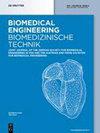LSTM网络的自动睡眠评分:时间粒度和输入信号的影响
IF 1.8
4区 医学
Q4 ENGINEERING, BIOMEDICAL
引用次数: 1
摘要
有监督的自动睡眠评分算法通常使用人工标注睡眠阶段标签的PSG数据进行训练。在这项研究中,我们研究了使用不同PSG输入信号的较短时间对长短期记忆(LSTM)神经网络的训练和测试的影响。LSTM模型在公共数据集提供的30秒epoch睡眠阶段标签以及10秒细分上进行评估。此外,三个独立的评分者在较短的时间窗口上重新标记数据集的子集。在重新标注的子集上重复自动睡眠评分实验。在单通道额叶脑电图的30 s epoch特征提取上,获得了最高的性能。准确度、精密度和召回率分别为92.22%、67.58%和66.00%。当使用较短的epoch作为输入时,性能下降了大约20%。在较短的时间点上重新标注数据集的子集并没有改善结果,反而进一步改变了睡眠阶段检测性能。结果表明,基于特征的LSTM分类算法在30秒的PSG epoch上的表现优于10秒的PSG epoch。未来的工作可能是确定不同epoch大小是否会改善不同类型分类算法的分类结果。本文章由计算机程序翻译,如有差异,请以英文原文为准。
Automatic sleep scoring with LSTM networks: impact of time granularity and input signals
Abstract Supervised automatic sleep scoring algorithms are usually trained using sleep stage labels manually annotated on 30 s epochs of PSG data. In this study, we investigate the impact of using shorter epochs with various PSG input signals for training and testing a Long Short Term Memory (LSTM) neural network. An LSTM model is evaluated on the provided 30 s epoch sleep stage labels from a publicly available dataset, as well as on 10 s subdivisions. Additionally, three independent scorers re-labeled a subset of the dataset on shorter time windows. The automatic sleep scoring experiments were repeated on the re-annotated subset.The highest performance is achieved on features extracted from 30 s epochs of a single channel frontal EEG. The resulting accuracy, precision and recall were of 92.22%, 67.58% and 66.00% respectively. When using a shorter epoch as input, the performance decreased by approximately 20%. Re-annotating a subset of the dataset on shorter time epochs did not improve the results and further altered the sleep stage detection performance. Our results show that our feature-based LSTM classification algorithm performs better on 30 s PSG epochs when compared to 10 s epochs used as input. Future work could be oriented to determining whether varying the epoch size improves classification outcomes for different types of classification algorithms.
求助全文
通过发布文献求助,成功后即可免费获取论文全文。
去求助
来源期刊
CiteScore
3.50
自引率
5.90%
发文量
58
审稿时长
2-3 weeks
期刊介绍:
Biomedical Engineering / Biomedizinische Technik (BMT) is a high-quality forum for the exchange of knowledge in the fields of biomedical engineering, medical information technology and biotechnology/bioengineering. As an established journal with a tradition of more than 60 years, BMT addresses engineers, natural scientists, and clinicians working in research, industry, or clinical practice.

 求助内容:
求助内容: 应助结果提醒方式:
应助结果提醒方式:


